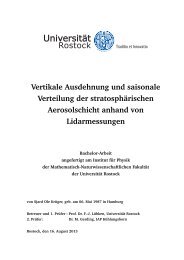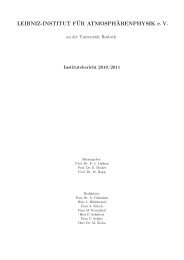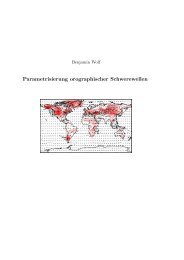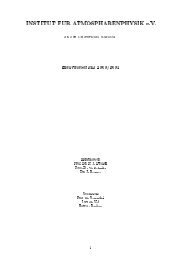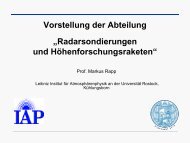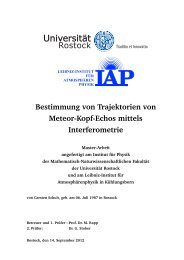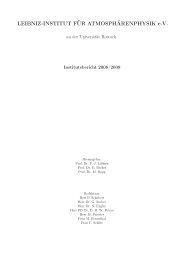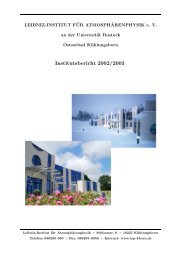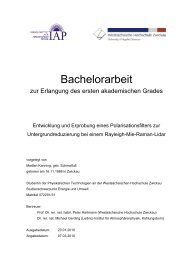Polar mesosphere summer echoes (PMSE): review of ... - HAL
Polar mesosphere summer echoes (PMSE): review of ... - HAL
Polar mesosphere summer echoes (PMSE): review of ... - HAL
Create successful ePaper yourself
Turn your PDF publications into a flip-book with our unique Google optimized e-Paper software.
M. Rapp and F. J. Lübken: Review <strong>of</strong> <strong>PMSE</strong> 2605<br />
Table 1. <strong>PMSE</strong> studies at different frequencies.<br />
Frequency Location Reference Reflectivity<br />
(Bragg scale)<br />
[MHz (m)] [m −1 ]<br />
2.78 (53.9) Tromsø, (69 ◦ N) Bremer et al. (1996b)<br />
8–9 (18.8) Vasil’surk, Russia (56 ◦ N) Karashtin et al. (1997)<br />
3.3, 4.9, 7.6 Gakona, Alaska, (62 ◦ N) Kelley et al. (2002)<br />
9, 11, 13. 15 Hankasalmi, Finnland, (62 ◦ N) Ogawa et al. (2003)<br />
49.6 (3.0) Tromsø, (69 ◦ N) Röttger et al. (1990) 2.0·10 −12<br />
50.0 (3.0) Poker Flat (65 ◦ N) Ecklund and Balsley (1981)<br />
Kelley and Ulwick (1988) 9.0·10 −15<br />
51.5 (2.9) Resolut Bay (75 ◦ N) Huaman et al. (2001)<br />
53.5 (2.8) Andøya, (69 ◦ N) Inhester et al. (1990) 4.0·10 −12<br />
53.5 (2.8) Svalbard, (78 ◦ N) Röttger (2001) 2.2·10 −14<br />
224 (0.67) Tromsø, (69 ◦ N) Hoppe et al. (1988) 1.5·10 −16<br />
Röttger et al. (1988)<br />
Hocking and Röttger (1997) 1.3·10 −15<br />
500 (0.3) Svalbard, (78 ◦ N) Röttger (2001) 5.3·10 −19<br />
933 (0.16) Tromsø, (69 ◦ N) Röttger et al. (1990) 1.2·10 −18<br />
1290 (0.12) Sondrestrom, (67 ◦ N) Cho and Kelley (1992)<br />
this new information does not change the general conclusion<br />
that the <strong>PMSE</strong>- and ice particle- existence period and altitude<br />
region are identical.<br />
2.2.2 Latitudinal variation<br />
Apart from the aforementioned measurements at ∼65–69 ◦ N,<br />
<strong>PMSE</strong> have also been observed as far North as 75 ◦ N and<br />
78 ◦ N (Huaman et al., 2001; Rüster et al., 2001; Lübken<br />
et al., 2004) and as far South as 52–54 ◦ N where the <strong>echoes</strong><br />
are then consequently called ‘<strong>mesosphere</strong> <strong>summer</strong> <strong>echoes</strong>’<br />
or MSE (Czechowsky et al., 1979; Reid et al., 1989; Thomas<br />
et al., 1992; Latteck et al., 1999b; Zecha et al., 2003). While<br />
a lot <strong>of</strong> general features like the typical echo strengths and<br />
the altitude region <strong>of</strong> occurrence are independent <strong>of</strong> the geographic<br />
latitude, it has been found that the occurrence rate<br />
shows a pronounced gradient with latitude (all values for 1<br />
July): the occurrence rate drops from almost 100% at 78 ◦ N<br />
(Lübken et al., 2004), ∼90% at 69 ◦ N (Bremer et al., 2003),<br />
to only ∼10–20% at 54 ◦ N (Zecha et al., 2003). This general<br />
picture is in line with recent 3d-model results <strong>of</strong> the thermal<br />
and dynamical structure <strong>of</strong> the <strong>mesosphere</strong> suggesting<br />
colder temperatures closer to the pole and hence a more favorable<br />
environment for the formation <strong>of</strong> ice particles (von<br />
Zahn and Berger, 2003). This picture is only ‘disturbed’<br />
by the observations at Resolut Bay (75 ◦ N) where low occurrence<br />
frequencies <strong>of</strong> less than ∼50% have been reported<br />
(Huaman et al., 2001).<br />
Note though that occurrence frequencies reported from<br />
different stations and radars must be considered with some<br />
caution since the radars are not identical in design and hence<br />
do not have the same absolute sensitivity. In particular, it<br />
must be noted that the VHF radar at Resolut Bay operated<br />
at a significantly smaller peak transmitted power (i.e., only<br />
12 kW compared to 36 kW in the case <strong>of</strong> the radars at 69 ◦ N<br />
and 54 ◦ N, and even 60 kW in the case <strong>of</strong> the SOUSY Svalbard<br />
radar at 78 ◦ N). Unfortunately, absolutely calibrated<br />
volume reflectivities from these radars are only available for<br />
some selected case studies (see Sect. 2.3.1) since absolute<br />
calibrations are extremely difficult to obtain. Nevertheless, in<br />
future experiments every effort should be undertaken to obtain<br />
<strong>PMSE</strong> measurements using calibrated signal strengths,<br />
since only this will allow to perform unambiguous comparisons<br />
<strong>of</strong> observations at different sites.<br />
<strong>PMSE</strong> have also been observed at Southern latitudes even<br />
though significantly less frequent than in the Northern hemisphere<br />
(Balsley et al., 1993, 1995; Woodman et al., 1999;<br />
Ogawa et al., 2002; Hosokawa et al., 2004). Possible<br />
hemispheric differences in the thermal and dynamical structure<br />
have been discussed (Dowdy et al., 2001; Becker and<br />
Schmitz, 2003; Siskind et al., 2003; Chu et al., 2003), however,<br />
the experimental data base is scarce such that the reason<br />
for the apparent hemispheric asymmetry remains to be identified<br />
(Lübken et al., 1999).<br />
2.2.3 Long term and short term variations<br />
Recently, first results on long term changes <strong>of</strong> <strong>PMSE</strong> properties<br />
have been reported. Bremer et al. (2003) considered<br />
mean <strong>PMSE</strong> occurrence frequencies for the years 1994<br />
through 2001 and found a significant positive correlation<br />
with the solar Ly-α radiation (the Ly-α flux varies by about<br />
www.atmos-chem-phys.org/acp/4/2601/ Atmos. Chem. Phys., 4, 2601–2633, 2004



